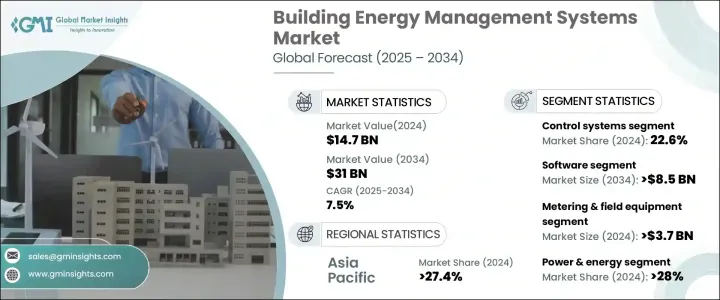
|
시장보고서
상품코드
1699291
빌딩 에너지 관리 시스템 시장 기회, 성장 촉진요인, 산업 동향 분석, 예측(2025-2034년)Building Energy Management Systems Market Opportunity, Growth Drivers, Industry Trend Analysis, and Forecast 2025-2034 |
||||||
세계의 빌딩 에너지 관리 시스템 시장은 2024년 147억 달러에 달했고, 2025년부터 2034년까지 연평균 복합 성장률(CAGR) 7.5%를 나타낼 것으로 예측됩니다.
엄격한 규제 프레임워크과 지속가능성에 대한 관심 증가를 배경으로 스마트 에너지 솔루션의 채용이 증가하고 있는 것이 이 확대에 박차를 가하고 있습니다. 이를 통해 첨단 에너지 관리 솔루션에 대한 수요를 높이고 있습니다.

AI 주도 분석, IoT 지원 자동화, 클라우드 기반 에너지 최적화 플랫폼의 통합으로 시장은 급속한 기술 발전을 목표로 하고 있습니다. 기업은 에너지 이용 개선, 건물 성능 향상, 적극적인 지속가능성 목표 달성을 위해 이러한 혁신을 활용하고 있습니다. 재생가능에너지에 대한 의존 증가와 탄소 실적 삭감의 중시가 함께 빌딩 에너지 관리 시스템의 채용이 더욱 가속화되고 있습니다. 또한 에너지 비용 상승과 송전망 신뢰성에 대한 우려가 높아짐에 따라 기업은 전력 사용을 최적화하기 위해 견고한 에너지 모니터링 시스템을 도입하고 있습니다. 지속 가능한 인프라와 스마트 빌딩에 대한 민간 부문의 투자는 기업이 장기적인 에너지 효율을 확보하면서 규제 준수를 달성하려고 하기 때문에 시장 성장을 가속하고 있습니다.
| 시장 범위 | |
|---|---|
| 시작 연도 | 2024년 |
| 예측 연도 | 2025-2034년 |
| 시작 금액 | 147억 달러 |
| 예측 금액 | 310억 달러 |
| CAGR | 7.5% |
소프트웨어 부문은 2034년까지 85억 달러를 창출할 것으로 예측되고 있으며, 대폭적인 확대가 예상되고 있습니다. 을 관리하는 방법에 혁명을 가져오고 있습니다. 에너지 배분과 소비 패턴을 최적화함으로써 기업은 비용을 절감하고 전체적인 효율을 향상시킬 수 있습니다.
전력 및 에너지 부문은 2024년 시장 점유율 전체의 28%를 차지했으며, 그 영향력은 향후 수년간 크게 확대될 것으로 예상됩니다. 배출량을 줄이기 위해 에너지 효율이 높은 기술에 대한 전략적 투자를 실시했습니다.
미국의 빌딩 에너지 관리 시스템 시장은 2024년에 29억 달러로 평가되었으며, 현저한 도입의 급증을 경험하고 있습니다. 정부의 지원 정책이나 에너지 효율 의무화 등의 규제 조치는 고도의 에너지 관리 시스템의 통합을 촉진하는 명확한 기준을 마련해 업계를 형성하고 있습니다.
목차
제1장 조사 방법과 조사 범위
- 시장의 정의
- 기본 추정과 계산
- 예측 계산
- 데이터 소스
제2장 주요 요약
제3장 업계 인사이트
- 생태계 분석
- 규제 상황
- 업계에 미치는 영향요인
- 성장 촉진요인
- 업계의 잠재적 위험 및 과제
- 성장 가능성 분석
- Porter's Five Forces 분석
- PESTEL 분석
제4장 경쟁 구도
- 전략 대시보드
- 혁신과 지속가능성의 전망
제5장 시장 규모와 예측 : 구성 요소별(2021-2034년)
- 주요 동향
- 계량 및 현장 장비
- 하드웨어
- 소프트웨어
- 네트워크 장치
- 제어 시스템
- 센서
- 기타
제6장 시장 규모와 예측 : 용도별(2021-2034년)
- 주요 동향
- 전력 및 에너지
- IT
- 제조
- 엔터프라이즈
- 헬스케어
- 기타
제7장 시장 규모와 예측 : 지역별(2021-2034년)
- 주요 동향
- 북미
- 미국
- 캐나다
- 멕시코
- 유럽
- 영국
- 프랑스
- 독일
- 이탈리아
- 러시아
- 스페인
- 아시아태평양
- 중국
- 호주
- 인도
- 일본
- 한국
- 중동 및 아프리카
- 사우디아라비아
- 아랍에미리트(UAE)
- 튀르키예
- 남아프리카
- 이집트
- 라틴아메리카
- 브라질
- 아르헨티나
제8장 기업 프로파일
- ABB
- C3.ai
- Dexma Sensors
- Eaton
- Emerson Electric
- ENGIE Impact
- eSight Energy
- General Electric
- GridPoint
- Honeywell
- IBM
- Ingersoll Rand
- Johnson Controls
- Mitsubishi Heavy Industries
- NX Technologies
- Optimum Energy
- Rockwell Automation
- Schneider Electric
- Siemens
- SkyFoundry
- Telkonet
- Toshiba
The Global Building Energy Management System Market reached USD 14.7 billion in 2024 and is projected to expand at a CAGR of 7.5% between 2025 and 2034. The increasing adoption of smart energy solutions, driven by stringent regulatory frameworks and a growing focus on sustainability, is fueling this expansion. Governments worldwide are implementing policies that require commercial and industrial buildings to deploy energy-efficient technologies, pushing demand for advanced energy management solutions. Rising energy consumption and the need to minimize operational costs have further incentivized businesses to invest in cutting-edge BEMS technologies.

With the integration of AI-driven analytics, IoT-enabled automation, and cloud-based energy optimization platforms, the market is witnessing rapid technological advancements. Companies are leveraging these innovations to improve energy utilization, enhance building performance, and meet aggressive sustainability goals. The increasing reliance on renewable energy sources, coupled with the growing emphasis on carbon footprint reduction, is further accelerating BEMS adoption. Additionally, the escalating energy costs and rising concerns over grid reliability are prompting businesses to implement robust energy monitoring systems to optimize electricity usage. Private sector investments in sustainable infrastructure and smart buildings are driving market growth as enterprises seek to achieve regulatory compliance while ensuring long-term energy efficiency.
| Market Scope | |
|---|---|
| Start Year | 2024 |
| Forecast Year | 2025-2034 |
| Start Value | $14.7 Billion |
| Forecast Value | $31 Billion |
| CAGR | 7.5% |
The software segment is poised for substantial expansion, with projections indicating it will generate USD 8.5 billion by 2034. Businesses are prioritizing intelligent energy monitoring and automation to streamline operations and reduce energy wastage. Advanced software solutions equipped with real-time data analytics and AI-powered automation are revolutionizing the way organizations manage their energy needs. By optimizing energy distribution and consumption patterns, these solutions enable companies to lower costs and improve overall efficiency. With industries shifting towards digital transformation, the demand for smart energy management software continues to rise, positioning it as a key driver of market growth in the coming decade.
The power and energy sector accounted for 28% of the total market share in 2024, and its influence is expected to expand significantly in the coming years. Rapid industrialization and urbanization have led to an unprecedented surge in global energy demand, increasing the need for sophisticated energy management solutions. Organizations across the power generation and distribution sectors are making strategic investments in energy-efficient technologies to optimize resource utilization and reduce carbon emissions. The growing integration of renewable energy sources, such as solar and wind power, is further contributing to the rising adoption of BEMS solutions. As companies focus on sustainable development and energy conservation, the sector remains a crucial growth area for BEMS providers worldwide.
The US building energy management system market was valued at USD 2.9 billion in 2024 and is experiencing a notable surge in adoption. The modernization of building infrastructure, coupled with the growing emphasis on energy optimization, is driving demand across commercial and residential sectors. By 2034, the North American market is expected to generate USD 7.5 billion, fueled by increasing investments in smart building technologies. Regulatory measures, including government-backed policies and energy efficiency mandates, are shaping the industry by establishing clear standards that encourage the integration of advanced energy management systems. As companies seek to enhance operational efficiency and meet sustainability targets, the shift towards intelligent building technologies is set to propel market expansion over the next decade.
Table of Contents
Chapter 1 Methodology & Scope
- 1.1 Market definitions
- 1.2 Base estimates & calculations
- 1.3 Forecast calculation
- 1.4 Data sources
- 1.4.1 Primary
- 1.4.2 Secondary
- 1.4.2.1 Paid
- 1.4.2.2 Public
Chapter 2 Executive Summary
- 2.1 Industry synopsis, 2021 - 2034
Chapter 3 Industry Insights
- 3.1 Industry ecosystem analysis
- 3.2 Regulatory landscape
- 3.3 Industry impact forces
- 3.3.1 Growth drivers
- 3.3.2 Industry pitfalls & challenges
- 3.4 Growth potential analysis
- 3.5 Porter's analysis
- 3.5.1 Bargaining power of suppliers
- 3.5.2 Bargaining power of buyers
- 3.5.3 Threat of new entrants
- 3.5.4 Threat of substitutes
- 3.6 PESTEL analysis
Chapter 4 Competitive landscape, 2024
- 4.1 Strategic dashboard
- 4.2 Innovation & sustainability landscape
Chapter 5 Market Size and Forecast, By Component, 2021 – 2034 (USD Million)
- 5.1 Key trends
- 5.2 Metering & field equipment
- 5.3 Hardware
- 5.4 Software
- 5.5 Networking device
- 5.6 Control systems
- 5.7 Sensors
- 5.8 Others
Chapter 6 Market Size and Forecast, By Application, 2021 – 2034 (USD Million)
- 6.1 Key trends
- 6.2 Power & energy
- 6.3 IT
- 6.4 Manufacturing
- 6.5 Enterprise
- 6.6 Healthcare
- 6.7 Others
Chapter 7 Market Size and Forecast, By Region, 2021 – 2034 (USD Million)
- 7.1 Key trends
- 7.2 North America
- 7.2.1 U.S.
- 7.2.2 Canada
- 7.2.3 Mexico
- 7.3 Europe
- 7.3.1 UK
- 7.3.2 France
- 7.3.3 Germany
- 7.3.4 Italy
- 7.3.5 Russia
- 7.3.6 Spain
- 7.4 Asia Pacific
- 7.4.1 China
- 7.4.2 Australia
- 7.4.3 India
- 7.4.4 Japan
- 7.4.5 South Korea
- 7.5 Middle East & Africa
- 7.5.1 Saudi Arabia
- 7.5.2 UAE
- 7.5.3 Turkey
- 7.5.4 South Africa
- 7.5.5 Egypt
- 7.6 Latin America
- 7.6.1 Brazil
- 7.6.2 Argentina
Chapter 8 Company Profiles
- 8.1 ABB
- 8.2 C3.ai
- 8.3 Dexma Sensors
- 8.4 Eaton
- 8.5 Emerson Electric
- 8.6 ENGIE Impact
- 8.7 eSight Energy
- 8.8 General Electric
- 8.9 GridPoint
- 8.10 Honeywell
- 8.11 IBM
- 8.12 Ingersoll Rand
- 8.13 Johnson Controls
- 8.14 Mitsubishi Heavy Industries
- 8.15 NX Technologies
- 8.16 Optimum Energy
- 8.17 Rockwell Automation
- 8.18 Schneider Electric
- 8.19 Siemens
- 8.20 SkyFoundry
- 8.21 Telkonet
- 8.22 Toshiba



















